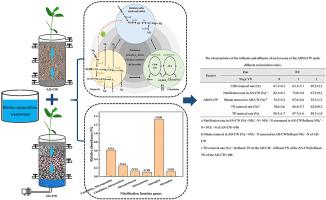Chemosphere ( IF 8.1 ) Pub Date : 2023-02-14 , DOI: 10.1016/j.chemosphere.2023.138157 Lin Zhao , Guiping Fu , Weicheng Pang , Xiaxin Li , Chao Pan , Zhangli Hu

|
We undertook a lab-scale evaluation of a novel autotrophic denitrification and nitrification integrated constructed wetland (ADNI-CW) for improved carbon (C), nitrogen (N), and sulfur (S) cycling to treat mariculture wastewater. The process involved an up-flow autotrophic denitrification constructed wetland unit (AD-CW) for sulfate reduction and autotrophic denitrification, and an autotrophic nitrification constructed wetland unit (AN-CW) for nitrification. The 400-day experiment investigated the performance of the AD-CW, AN-CW, and entire ADNI-CW processes under various hydraulic retention times (HRTs), nitrate concentrations, dissolved oxygen levels, and recirculation ratios. Under various HRTs, the AN-CW achieved a nitrification performance exceeding 92%. Correlation analysis of the chemical oxygen demand (COD) revealed that, on average, approximately 96% of COD was removed by sulfate reduction. Under different HRTs, increases in influent NO3−–N concentrations caused the amount of sulfide to gradually decrease from sufficient to deficient, and the autotrophic denitrification rate also decreased from 62.18 to 40.93%. In addition, when the NO3−–N load rate was above 21.53 g N/m2·d, the transformation of organic N by mangrove roots may have increased NO3−–N in the top effluent of the AD-CW. The coupling of N and S metabolic processes mediated by various functional microorganisms (Proteobacteria, Chloroflexi, Actinobacteria, Bacteroidetes, and unclassified_d__Bacteria) enhanced N removal. We intensively explored the effects of changing inputs as culture species developed on the physical, chemical, and microbial changes of CW to ensure a consistent and effective management of C, N, and S. This study lays the foundation for green and sustainable mariculture development.
中文翻译:

一种新型自养反硝化一体化人工湿地处理海水养殖废水的工艺
我们对新型自养反硝化和硝化一体化人工湿地 (ADNI-CW) 进行了实验室规模的评估,以改善碳 (C)、氮 (N) 和硫 (S) 循环以处理海水养殖废水。该过程涉及用于硫酸盐还原和自养反硝化的上流式自养反硝化人工湿地装置(AD-CW)和用于硝化的自养硝化人工湿地装置(AN-CW)。为期 400 天的实验研究了 AD-CW、AN-CW 和整个 ADNI-CW 工艺在各种水力停留时间 (HRT)、硝酸盐浓度、溶解氧水平和再循环率下的性能。在各种 HRT 下,AN-CW 的硝化性能超过 92%。化学需氧量 (COD) 的相关性分析表明,平均而言,约 96% 的 COD 通过硫酸盐还原去除。在不同的 HRT 下,进水 NO 的增加3 - -N浓度使硫化物量由充足逐渐减少,自养反硝化率也由62.18%下降到40.93%。此外,当NO 3 − –N 负荷率高于21.53 g N/m 2 ·d 时,红树根系对有机氮的转化可能增加了AD-CW 顶层出水中的NO 3 − –N。由各种功能微生物介导的 N 和 S 代谢过程的耦合(变形杆菌、Chloroflexi、放线菌、拟杆菌和未分类的_d__细菌) 增强 N 去除。我们深入探讨了随着养殖物种的发展而改变投入对 CW 的物理、化学和微生物变化的影响,以确保对 C、N 和 S 进行一致和有效的管理。这项研究为绿色和可持续的海水养殖发展奠定了基础。































 京公网安备 11010802027423号
京公网安备 11010802027423号